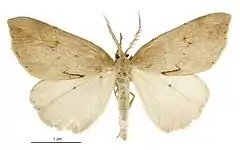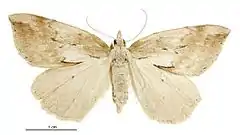Pseudocoremia lutea
Pseudocoremia lutea is a species of moth in the family Geometridae. It is endemic to New Zealand. It is classified as "At Risk, Naturally Uncommon" by the Department of Conservation.
| Pseudocoremia lutea | |
|---|---|
 | |
| Male | |
 | |
| Female | |
| Scientific classification | |
| Kingdom: | |
| Phylum: | |
| Subphylum: | |
| Class: | |
| Order: | |
| Family: | |
| Tribe: | |
| Genus: | |
| Species: | P. lutea |
| Binomial name | |
| Pseudocoremia lutea | |
| Synonyms[2] | |
| |
Taxonomy
This species was first described by Alfred Philpott in 1914 using specimens collected at Bold Peak, Humboldt Range by C. Fenwick and George Howes in December and January.[3] Philpott named the species Selidosema lutea. George Hudson, using the same name, described and illustrated this species in his 1928 book The Butterflies and Moths of New Zealand.[4] In 1988 John S. Dugdale assigned the species to the genus Pseudocoremia.[2] The holotype specimen is held at the Museum of New Zealand Te Papa Tongarewa.[5]
Description
Philpott described the species as follows:
♂︎. 47 mm. Head, palpi, and thorax dull yellowish-brown, face paler. Antennae moderately bipectinated, yellowish - brown. Abdomen pale yellow-brown. Forewings strongly arched at base, costa faintly sinuate, apex subacute, termen sinuate, rounded beneath, oblique ; dull yellowish-brown with a few scattered blackish scales, most plentiful near apex ; basal line indicated by a few blackish scales at dorsum ; first line much interrupted, dentate, black, most pronounced as an inwardly oblique mark on dorsum ; a series of obscure interneural black dots on termen : cilia dull yellowish-brown with obscure darker line. Hindwings, termen sinuate ; very pale yellowish-brown ; a prominent black discal dot and some black scales round termen : cilia pale yellowish-brown with faint darker line and tips whitish.[3]
Distribution
This species is endemic to New Zealand.[1][6] This species can only be found in the Otago Lakes area.[7]
Biology and host species
The biology and host species of this moth is unknown.[7]
Conservation status
This species has been classified under the New Zealand Threat Classification system as being "At Risk, Naturally Uncommon".[8]
References
| Wikimedia Commons has media related to Pseudocoremia lutea. |
- "Pseudocoremia lutea (Philpott, 1914)". www.nzor.org.nz. Landcare Research New Zealand Ltd. Retrieved 2018-05-25.
- Dugdale, J. S. (1988). "Lepidoptera - annotated catalogue, and keys to family-group taxa" (PDF). Fauna of New Zealand. 14: 168 – via Landcare Research New Zealand Ltd.
- Philpott, Alfred (1914). "Descriptions of new species of Lepidoptera". Transactions and Proceedings of the New Zealand Institute. 46: 118–121 – via Biodiversity Heritage Library.
- Hudson, G. V. (1928). The Butterflies and Moths of New Zealand. Wellington: Ferguson & Osborn Ltd. p. 142.
- "Selidosema lutea Philpott, 1914". collections.tepapa.govt.nz. Museum of New Zealand Te Papa Tongarewa. Retrieved 2018-05-25.
- Gordon, Dennis P., ed. (2010). New Zealand inventory of biodiversity. Volume two. Kingdom animalia : chaetognatha, ecdysozoa, ichnofossils. Vol. 2. Christchurch, N.Z.: Canterbury University Press. p. 459. ISBN 9781877257933. OCLC 973607714.
- Patrick, Brian; Dugdale, John S. (2000). Conservation status of the New Zealand Lepidoptera (PDF). Wellington, New Zealand: Department of Conservation. p. 28. ISBN 0478218672.
- Hoare, R.J.B.; Dugdale, J.S.; Edwards, E.D.; Gibbs, G.W.; Patrick, B.H.; Hitchmough, R.A.; Rolfe, J.R. (2017). Conservation status of New Zealand butterflies and moths (Lepidoptera), 2015 (PDF). Wellington, New Zealand: New Zealand Department of Conservation. p. 30. ISBN 9781988514383.